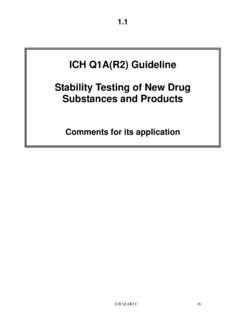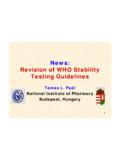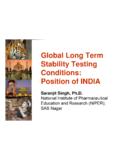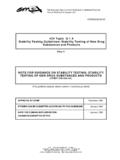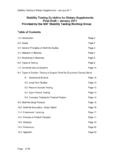Transcription of STABILITY TESTING OF ACTIVE SUBSTANCES AND ... - WHO
1 Working document RESTRICTED STABILITY TESTING OF ACTIVE SUBSTANCES AND pharmaceutical PRODUCTS _____ World Health Organization 2006 All rights reserved. This draft is intended for a restricted audience only, the individuals and organizations having received this draft. The draft may not be reviewed, abstracted, quoted, reproduced, transmitted, distributed, translated or adapted, in part or in whole, in any form or by any means outside these individuals and organizations (including the organizations concerned staff and member organizations) without the permission of WHO.
2 The draft should not be displayed on any web site. Please send any request for permission to: Dr Sabine Kopp, Quality Assurance & Safety: Medicines (QSM), Department of Medicines Policy and Standards (PSM), World Health Organization, CH-1211 Geneva 27, Switzerland. Fax: (41-22) 791 4730; e-mails: The designations employed and the presentation of the material in this draft do not imply the expression of any opinion whatsoever on the part of the World Health Organization concerning the legal status of any country, territory, city or area or of its authorities, or concerning the delimitation of its frontiers or boundaries. Dotted lines on maps represent approximate border lines for which there may not yet be full agreement.
3 The mention of specific companies or of certain manufacturers products does not imply that they are endorsed or recommended by the World Health Organization in preference to others of a similar nature that are not mentioned. Errors and omissions excepted, the names of proprietary products are distinguished by initial capital letters. The World Health Organization does not warrant that the information contained in this draft is complete and correct and shall not be liable for any damages incurred as a result of its use. Discussions are currently ongoing with the WHO Eastern Mediterranean Region towards a synergistic approach in developing a global text to include the STABILITY test conditions adopted by the WHO Expert Committee on Specifications for pharmaceutical Preparations.
4 The aim is to use the new text as a replacement for the WHO guidelines for STABILITY TESTING of pharmaceutical products containing well established drug SUBSTANCES in conventional dosage forms, which were published in 1996. More information can be found on STABILITY related issues at the following web site: http:// Please address any comments you may have on this above described approach , by 5 October 2006, to Dr S. Kopp, Quality Assurance and Safety: Medicines, Medicines Policy and Standards, World Health Organization, 1211 Geneva 27, Switzerland, fax: (+41 22) 791 4730 or e-mail: with a copy to Working document page 2 REGIONAL GUIDELINE FOR THE WHO EASTERN MEDITERRANEAN REGION STABILITY TESTING OF ACTIVE SUBSTANCES AND pharmaceutical PRODUCTS DRAFT 19 April 2006 This guideline has been developed during the WHO EMRO Consultation on Regional Guidelines on STABILITY Studies of Medicines and Biologicals, Jeddah, 25-28 February 2006.
5 The final draft is recommended for adoption by the EMR regional committee. Working document page 3 TABLE OF CONTENTS 1. INTRODUCTION .. 4 Objectives of the Guideline .. 4 Scope of the 4 General Principles .. 4 2. GUIDELINES .. 5 ACTIVE 5 General .. 5 Stress TESTING .. 5 Selection of Batches .. 6 Container Closure System .. 6 6 TESTING Frequency.
6 6 Storage Conditions .. 7 STABILITY Commitment .. 9 9 Statements/Labelling .. 10 pharmaceutical 10 General .. 10 Selection of Batches .. 11 Container Closure System .. 11 11 TESTING Frequency .. 11 Storage Conditions .. 12 STABILITY Commitment .. 16 17 Statements/Labelling .. 18 In-use STABILITY .. 19 Variations .. 20 On-going STABILITY Studies .. 20 3. GLOSSARY .. 21 ANNEX 1 .. 27 Assignment of climatic zones and recommended storage conditions .. 27 ANNEX 2 .. 29 TESTING 29 REFERENCES .. 32 Working document page 4 STABILITY TESTING OF ACTIVE SUBSTANCES AND pharmaceutical PRODUCTS 1.
7 INTRODUCTION Objectives of the Guideline The following guideline defines the STABILITY data package for ACTIVE SUBSTANCES and pharmaceutical products that is sufficient for a registration application within countries belonging to the World Health Organization (WHO)i Eastern Mediterranean Region (EMR)ii. The principle has been established that STABILITY information would be acceptable in all EMR member states, provided the information is consistent with this guideline. The guideline seeks to exemplify the core STABILITY data package required for registration. However, alternative approaches can be used when they are scientifically justified. Further guidance can be found in ICH guidelinesiii. Scope of the Guideline The guideline addresses the information to be submitted in registration applications for New Chemical Entities as well as existing ACTIVE SUBSTANCES and their related pharmaceutical products for human use.
8 General Principles The purpose of STABILITY TESTING is to provide evidence on how the quality of an ACTIVE substance or pharmaceutical product varies with time under the influence of a variety of environmental factors such as temperature, humidity, and light. In addition, product -related factors influence the STABILITY , the chemical and physical properties of the ACTIVE substance and the pharmaceutical excipients, the dosage form and its composition, the manufacturing process, the nature of the container-closure system, and the properties of the packaging materials. Also, the STABILITY of excipients that may contain or form reactive degradation products, have to be considered. As a result of STABILITY TESTING a re-test period for the ACTIVE substance or a shelf life for the pharmaceutical product can be established, and storage conditions can be recommended.
9 In order to identify adequate TESTING conditions, the climate in the EMR member states has been analysed using the climatic data extracted from the ERA-40 reanalysis of ECMWFiv. The Mean Kinetic Temperature (MKT), which includes the reaction rate constants in the evaluation of heat effects on pharmaceutical products, and the mean partial water vapour pressure in any part of the region have been calculated, and accordingly a climatic zone for each EMR member state has been assigned (see Annex 1). Working document page 5 2.
10 GUIDELINES ACTIVE substance General Information on the STABILITY of the ACTIVE substance is an integral part of the systematic approach to STABILITY evaluation. For ACTIVE SUBSTANCES not described in an official pharmacopoeial monograph, STABILITY studies are required. For ACTIVE SUBSTANCES described in an official pharmacopoeial monograph, which covers the degradation products and for which suitable limits have been set but a re-test period is not defined, two options are acceptable: a) The manufacturer of the pharmaceutical product confirms that the ACTIVE substance complies with the pharmacopoeial monograph immediately prior to the manufacture of the pharmaceutical product .










